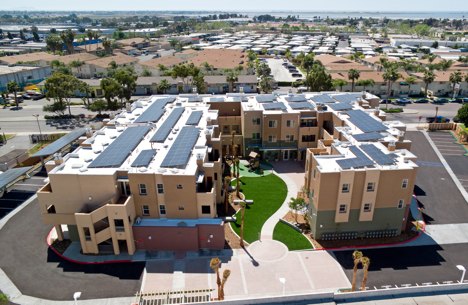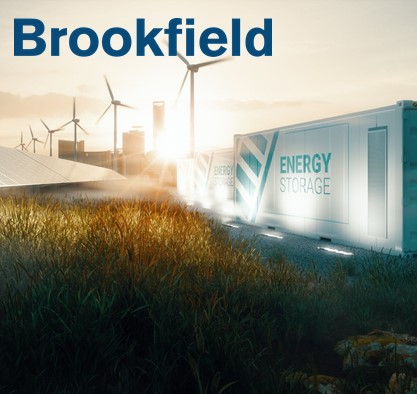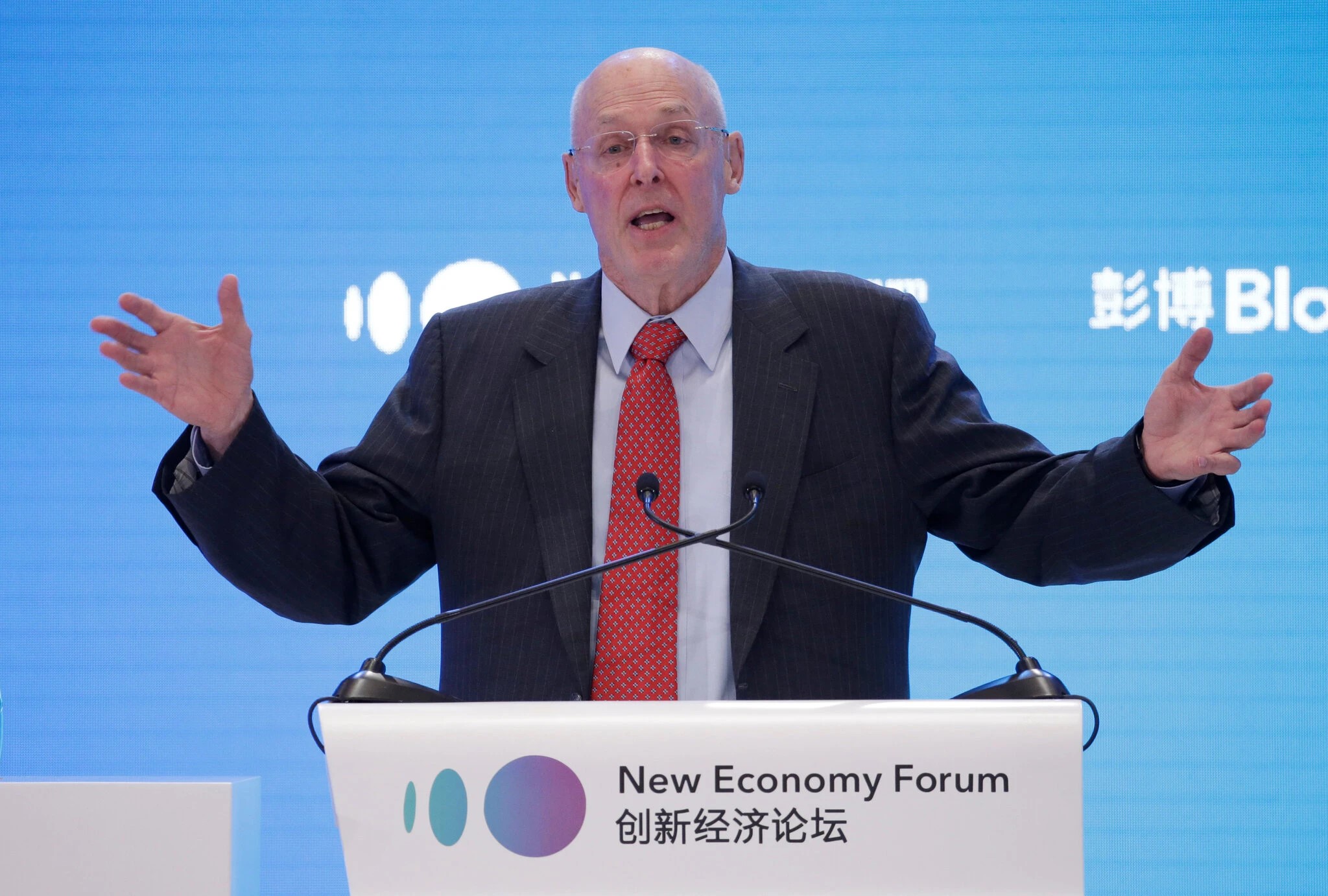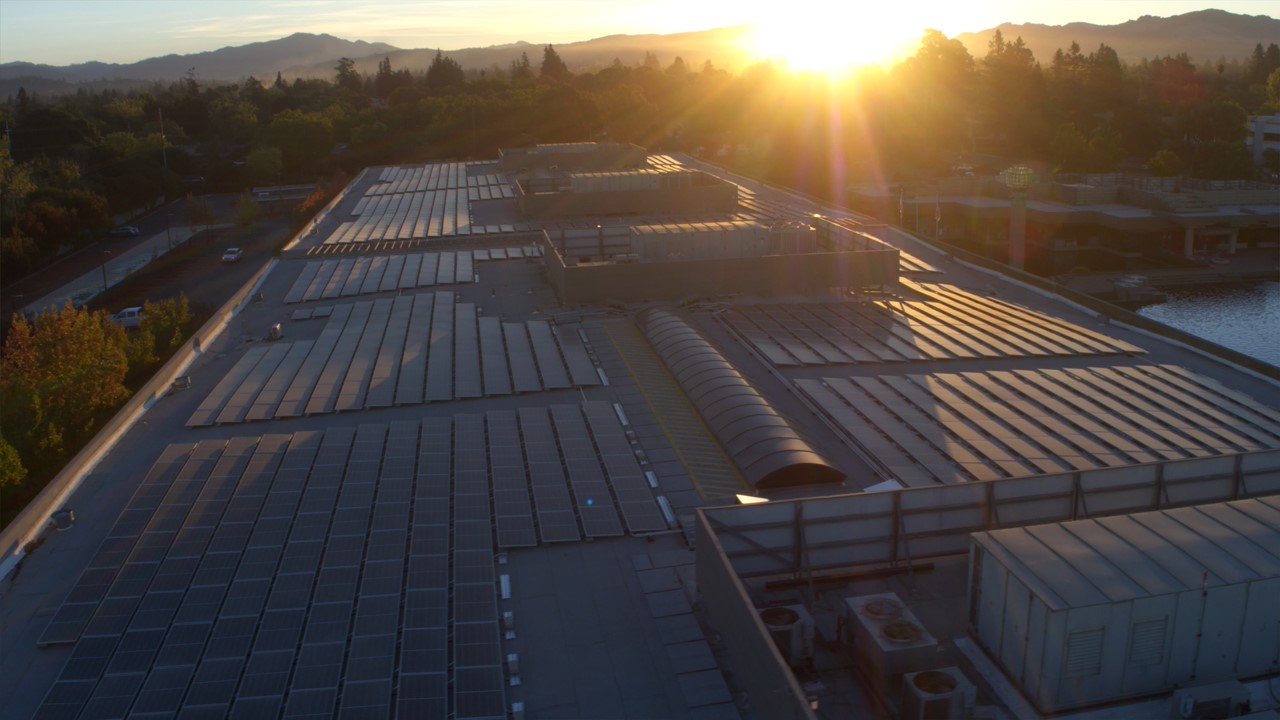Solar is not just for homeowners. The advent ofcommunity solar is now enabling those who don’t own a home to go solar and enjoy all of its benefits. But regardless of whether someone decides to own or rent, solar still seems to be for those who have a disposal income. That is, until now.
Last October, California Gov. Jerry Brown signed the nation’s largest solar bill for low-income renters. The Multifamily Affordable Housing Solar Roofs Program was created under AB693, which will dedicate about $100 million per year over a period of ten years.
“AB 693 is a very important new program for California because now, all consumers, including renters can enjoy the benefits of pollution free solar electricity generated right where we live and work,” Bernadette Del Chiaro, executive director of California Solar Energy Industries Association (CALSEIA), said.

464 kW PV system on “Park Villas” Multifamily Affordable housing with 268 tenants. Credit: Everyday Energy
The new program has the goal to install at least 300 MW of rooftop solar PV on multifamily affordable housing projects.
“
Everyday Energy is a California-based solar project developer for multifamily affordable housing. The company has worked closely with CALSEIA, the California Environmental Justice Alliance (CALEJA) and Assemblymember Susan Eggman, who is the author of AB693.
“This program was born out of necessity,” Sarem said.
Although California is the largest solar state in the U.S. and has a track record of implementing solar on multifamily affordable housing, the existing program has failed to reach out to low-income renters and disadvantaged communities in California.
Demand to Create a Bigger Successor of MASH Program
In 2008, the California Public Utilities Commission (CPUC) established the Multifamily Affordable Solar Housing (MASH) program as a component of the California Solar Initiative (CSI), the nation’s largest ratepayer-funded solar program.
The MASH program received a budget of $108.3 million, or 10 percent of CSI program funds, to stimulate and encourage solar installations on existing multifamily affordable housing properties. It was so successful that 100 percent of the available funding was reserved quickly. In 2013, the legislature passed a bill (AB 217) authorizing the extension of MASH with an additional $54 million in funding and a 35 MW installed capacity goal for the program.
Between the program’s inception and now, MASH has completed 356 projects, representing 26.1 MW-DC of installed capacity statewide. However, that means that MASH has served only 6,700 low-income renters. An analysis by the Center for American Progress reported that only 4.2 percent of the solar installations under the CSI served households with incomes of less than $40,000 per year.

Lower-income families are more vulnerable to energy costs than higher-income families because energy represents a large portion of their household budgets. Reducing electricity bills with solar can help those families to reduce a financial burden and spend money on other necessities, such as food or health care.
AB 693 would fill the deficit and extend the direct economic benefits of solar systems to low-income renters.
Program Benefits Everyone Through Reduction in Low-Income Rate Assistance
While MASH was funded by electric ratepayers, the new program will be funded by “cap-and-trade money, [with] no additional cost and no subsidy by taxpayers,” Sarem said. From July 1, 2016, through June 30, 2026, the CPUC will annually authorize the allocation of $100 million, or 10 percent of available funds, whichever is less, from the Greenhouse Gas (GHG) Option Revenues, which are collected from large GHG emitters.
The program funded by cap-and-trade not only benefits tenants at low-income multi-family housing properties, but also all the ratepayers statewide. Here’s how:
California requires utilities to assist energy customers with household incomes that are at or below 200 percent of the federal poverty line. The program knowns as California Alternate Rates for Energy (CARE) offers discounted rates for low-income customers to meet basic needs, such as heating, cooling and lighting.
According to data provided by CPUC, over 4.5 million households are currently enrolled in the CARE program, representing about 84 percent of the total estimated eligible households. Low-income customers that are enrolled in the CARE program receive a 30-35 percent discount on their electric bills. In 2014, the subsidy program cost about $1.3million to utility ratepayers in California.
“Utility ratepayers would also benefit from solar offsets provided (by the new program) to CARE recipients, which would reduce the basis for calculating CARE discounts and thereby reduce CARE program outlay,” Sarem said.
Multifamily Affordable Solar Housing Moving Beyond California
Solar for multifamily affordable housing will expand beyond California. Last July, President Obama unveiled the Climate Action program, which includes a commitment to install 300 MW of solar systems across federally subsidized housing by 2020 and to make it easier for homeowners to borrow money for solar panels.
At the White House, the U.S. Department of Energy hosted the National Community Solar Summit in November 2015, bringing 68 partners, including cities, states and businesses, to create the National Community Solar Partnership. Everyday Energy, as a key participant, presented California as a best practice to further promote solar programs that benefit affordable housing communities nationwide.
Even though it is a goal set at the national level, right policies and infrastructure must be placed at the state level for better implementation. One of the important state-level policies is virtual net metering (VNM).
In California, VNM was first approved by the CPUC when the MASH Program was created. Under traditional net metering, one solar system is physically installed and connected to each utility account. However, VNM allows a multitenant building to install a single solar system for the benefit of multiple tenants by allocating energy credits among individual units as well as to common area load. It also allows for a more cost-effective design than traditional net metering.

202 kW system on “Parkview Terrace” multifamily affordable housing with 92 tenants in California. Credit: Everyday Energy
The term VNM is not particularly standardized or used consistently in the U.S. In California, the VNM applies to electric customers of multitenant buildings that share a common service delivery point while in other states, the term can be called “neighborhood net metering” or “community net metering,” and it can include and expand to participants from additional properties (either located on-site or off-site). Currently, at least 11 states (California, Colorado, Delaware, Illinois, Massachusetts, Maine, Minnesota, New York, Rhode Island, Vermont and Washington) and Washington, D.C., have authorized community net metering.
Some solar for multifamily affordable housing projects are underway in Massachusetts, New York and Washington D.C. under the neighborhood net metering arrangement.
“AB 693 represents the single biggest investment in rooftop solar for low-income consumers anywhere in the U.S.,” Del Chiaro said. “If implemented well by the CPUC, it should serve as a model for other states and become a historic program putting solar in the hands of everyone.”
This article was updated on Feb. 15, 2016, at 6:30 p.m. to correct the number of projects MASH has completed.





